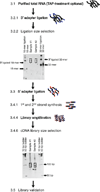Small RNA library cloning procedure for deep sequencing of specific endogenous siRNA classes in Caenorhabditis elegans
- PMID: 24920360
- PMCID: PMC5328689
- DOI: 10.1007/978-1-4939-0931-5_6
Small RNA library cloning procedure for deep sequencing of specific endogenous siRNA classes in Caenorhabditis elegans
Abstract
In recent years, distinct classes of small RNAs ranging in size from ~21 to 26 nucleotides have been discovered and shown to play important roles in a wide array of cellular functions. Because of the abundance of these small RNAs, library preparation from an RNA sample followed by deep sequencing provides the identity and quantity of a particular class of small RNAs. In this chapter we describe a detailed protocol for preparing small RNA libraries for deep sequencing on the Illumina platform from the nematode C. elegans.
Figures


References
-
- Kim VN, Han J, Siomi MC. Biogenesis of small RNAs in animals. Nat Rev Mol Cell Biol. 2009;10:126–139. - PubMed
MeSH terms
Substances
Grants and funding
LinkOut - more resources
Full Text Sources
Other Literature Sources

